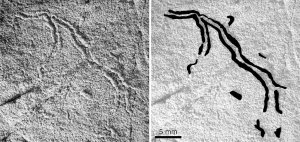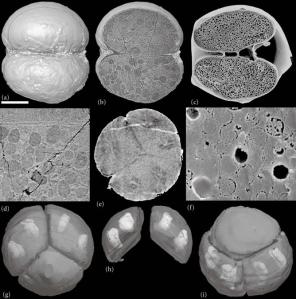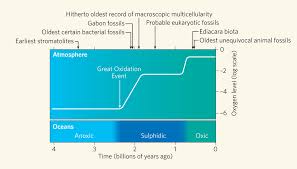It was the Cambrian period when there was an explosion of life forms on the plant. But in the Precambrian there is evidence for the origin of life. The well-known fossil history of the earth took place after the Precambrian and only accounts for one seventh of the history of life on the earth. The Proterozoic Eon, which was from 2.5 billion years ago to just under 550 million years ago. This was known as the great oxygenation event. [Benton & Harper, 2009] The time scale here is shown in fig. 1.
Many of these metazoans from the Precambrian period were mucus producing multicellular organisms. These organisms were called myxomitodes and the fossils are about 1.8 billion years old and found in Stirling Range, Western Australia. These particular fossils are likely the oldest locomotory trace fossil. [Benton & Harper, 2009] They were most likely small worm like creatures which moved randomly with no real destination, producing a trail of mucus like the modern snail or slug today. As shown in fig 2 the trails are random and uncoordinated.
Another metazoan revelation that dates back to the Precambrian was the finding of animal embryos from the Doushantou Formation in China. It was believed that these embryos found were that of an organism that may resemble modern sea urchin Heliocidaris. It is through the lipid vesicles that these fossils may be identified and compared with modern relatives. This is known as biomarker evidence, with are like fingerprints for the origin of life. Biomarkers are of great importance in the study of Precambrian life.
(c) and (f) show the comparison to a modern day sea urchin. The likes of amino acids are strong indicators of life forms. It was biomarkers which confirmed the presence of metazoans in the Precambrian, in the form of metazoan demosponges which have been reported from rocks older than the Ediacaran. [Benton & Harper, 2009]
The study of the Precambrian is a very difficult matter due the massive length of time that has past and the miniscule number of life forms that existed. It’s a painstaking process to determine the age and biological nature of metazoans alive in that time. The fossils of such an ancient time are removed for the rocks carefully using a sulphur isotope analyses. True multicellular organisms did not exist till the great oxidation event, so this 2.1 billion years ago is when these organisms began to colonise the earth as they evolved. Figure 4 shows the scale for atmospheric oxygen is the log of the partial pressure of O2 expressed in the atmosphere. [Antcliffe & Donoghue, 2010]
References
Introduction to Paleobiology and the Fossil Record, Michael J. Benton and David A. T. Harper. 2009 Chapters: 8, 10, Pages 188-190 235-239.
Nature journal. Origins of multicellularity, Philip C. J. Donoghue and Jonathan B. Antcliffe. 2010, vol 466 Page 41.
Figure 1: Introduction to Paleobiology and the Fossil Record, Michael J. Benton and David A. T. Harper. 2009 Chapters: 8, 10, Page 188
Figure 2: S. Bengston , B. Rasmussen, B. Krapež, 2007. The Paleoproterozoic megascopic Stirling biota . Paleobiology, 33, 3, 351-381.
Figure 3: Introduction to Paleobiology and the Fossil Record, Michael J. Benton and David A. T. Harper. 2009 Chapters: 8, 10, Page 238
Figure 4: Nature journal. Origins of multicellularity, Philip C. J. Donoghue and Jonathan B. Antcliffe. 2010, vol 466 Page 41.



